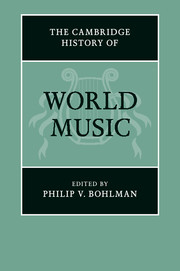Crossref Citations
This Book has been
cited by the following publications. This list is generated based on data provided by Crossref.
2014.
Publications Received.
Journal of the American Musicological Society,
Vol. 67,
Issue. 3,
p.
883.
Killick, Andrew
2017.
Traditional Music and the Work-Concept: TheKayagŭm Sanjoof Hwang Byungki.
Yearbook for Traditional Music,
Vol. 49,
Issue. ,
p.
1.
Bronfman, Alejandra
2017.
Sonic colour zones: Laura Boulton and the hunt for music.
Sound Studies,
Vol. 3,
Issue. 1,
p.
17.
Heldt, Katja
2018.
Transcultural Music-Making in Contemporary Music Ensembles: Five Approaches in Germany, the Netherlands, Uzbekistan and Turkey.
Circuit,
Vol. 28,
Issue. 1,
p.
45.
da Silva, Glaucia Peres
2018.
Musikwirtschaftsforschung.
p.
77.
Bithell, Caroline
2018.
The International Encyclopedia of Anthropology.
p.
1.
Bloechl, Olivia
and
Latour, Melinda
2019.
The Cambridge History of Sixteenth-Century Music.
p.
128.
Fenlon, Iain
and
Wistreich, Richard
2019.
The Cambridge History of Sixteenth-Century Music.
2020.
CHANG, HYUN KYONG HANNAH
2021.
Introduction to the Special Issue on Musics of Coeval East Asia.
Twentieth-Century Music,
Vol. 18,
Issue. 3,
p.
333.
Fukunaka, Fuyuko
2021.
Musical Entanglements between Germany and East Asia.
p.
227.
CHANG, HYUN KYONG HANNAH
2021.
Transcending the Past: Singing and the Lingering Cold War in the Korean Christian Diaspora.
Twentieth-Century Music,
Vol. 18,
Issue. 3,
p.
447.
PARK, HYE-JUNG
2021.
Musical Entanglements: Ely Haimowitz and Orchestral Music under the US Army Military Government in Korea, 1945–1948.
Journal of the Society for American Music,
Vol. 15,
Issue. 1,
p.
1.
Garzoli, John
and
Hin-on, Tharanat
2023.
Thai musicology in context: epistemic disparities in Thai and western ways of knowing Thai music.
Ethnomusicology Forum,
Vol. 32,
Issue. 2,
p.
224.
2024.
Liebersohn, Harry
2025.
Beethoven Imagines India: Personal Calling and Social Duties, 1815–1816.
Global Intellectual History,
Vol. 10,
Issue. 5,
p.
403.



